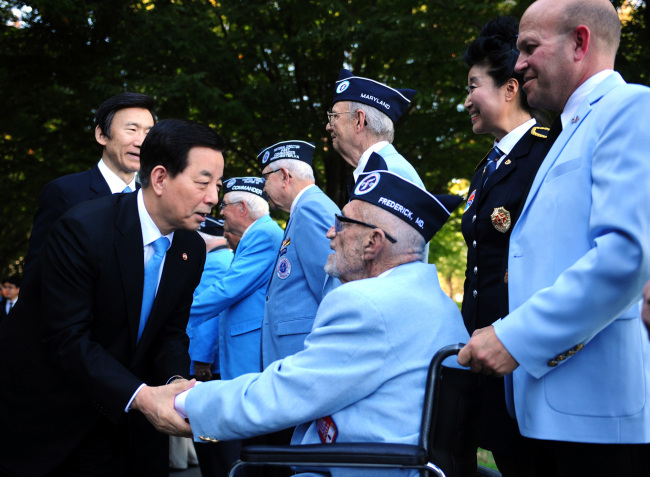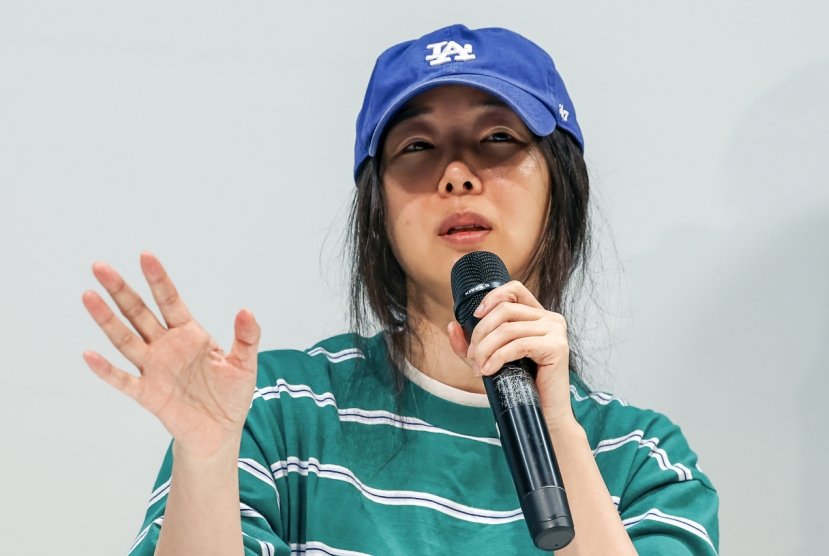South Korea’s foreign and defense ministers were set for biennial talks with their US counterparts Wednesday, the main topic of which will be the allies’ countermeasures on North Korea’s nuclear and missile threats and development of their alliance.
Foreign Minister Yun Byung-se and Defense Minister Han Min-koo will meet with US Secretary of State John Kerry and Defense Secretary Ash Carter for talks on the day, ahead of the 48th Security Consultative Meeting of the two countries’ defense ministers the following day.
Foreign Minister Yun Byung-se and Defense Minister Han Min-koo will meet with US Secretary of State John Kerry and Defense Secretary Ash Carter for talks on the day, ahead of the 48th Security Consultative Meeting of the two countries’ defense ministers the following day.

“As a response to an ‘unprecedented’ missile and nuclear threats from North Korea, the ‘2+2’ foreign and defense ministerial talks will have the top officials in the respective areas discussing comprehensive countermeasures on both foreign and military aspect,” said Yun, after arriving in Washington on Tuesday.
“In particular, we will talk about specifying and institutionalizing the extended deterrence, which is the key element of South Korea’s defense.”
Extended deterrence refers to threat of US nuclear retaliation in case of an attack on its allies.
The meeting comes as North Korea has been stepping up its nuclear and missile programs, under orders from leader Kim Jong-un. On Sept. 9, Pyongyang conducted its fifth nuclear test, which also marked the first time the country carried out two tests in one year. Later in the month, it revealed a ground test of a rocket engine believed to be part of its effort to develop an intercontinental ballistic missile that can reach the US mainland.
On Saturday, it conducted a test launch, which ultimately failed, of its Musudan intermediate-range ballistic missile, assessed to be able to strike a US base in Guam.
“(The meeting) is more significant than ever since it takes place under constant threats from the North while its nuclear program is being enhanced,” said Han. “We will discuss ways to ensure that the extended deterrence -- including the nuclear umbrella of the US -- will be implemented, along with various ways to strengthen the Seoul-Washington alliance.”
According to the ministers, the allies are to discuss both the unilateral and UN-led sanctions on Pyongyang, along with other means of pressuring the communist states.
Yun said that four ministers will discuss how to maximize the efforts of multi-legged sanction on the communist country.
North Korea is already under sanctions from the UN Security Council resolution, adopted in March after its nuclear test in January and long-range rocket launch in February.
The South Korean and US minister will also evaluate the accomplishments of both administrations in the diplomatic and security fields.
In light of growing threats from the North, there have been calls locally for stronger defense measures. The allies kicked off talks for deployment of the US Terminal High Altitude Area Defense anti-missile system here on the heels of the February rocket launch, and have officially decided to install it in the country’s southeastern region by next year.
The stationing of the THAAD system -- which comes with a high-powered AN/TPY-2 radar system -- has sparked environmental concerns here and complaints from China about possibly interfering with its security interests.
During a briefing at the SCM, the two sides will check the progress on the THAAD deployment and reaffirm that it is aimed only at defending against North Korea and not against any other country.
Political hawks from the ruling Saenuri Party have even called for nuclear armament and deployment of a nuclear-powered submarine, with the government vowing to “carefully consider” the latter.
The military said they have no plans to discuss deployment of the nuclear submarine.
“(The specifics of the extended deterrence) will be announced after the SCM,” Han said.
The US has recently deployed its strategic assets on the Korean Peninsula, as the North stepped up belligerence.
This included sending the nuclear-powered aircraft carrier USS Ronald Reagan here to participate in the large-scale joint naval drill “Invincible Spirit” program, which concluded last week.
US Defense Secretary Ash Carter said Tuesday that the US is placing “some of our best military personnel and deploying some of our most advanced capabilities” in the Asia-Pacific region under US President Barack Obama’s “rebalance to Asia” policy.
“Those capabilities include F-22 and F-35 stealth fighter jets, P-8A Poseidon maritime patrol aircraft, V-22 Ospreys, B-2 bombers and our newest surface warfare ships,” he said.
Carter also emphasized efforts to forge stronger trilateral security cooperation among South Korea, the US and Japan against the North.
By Yoon Min-sik (minsikyoon@heraldcorp.com)
“In particular, we will talk about specifying and institutionalizing the extended deterrence, which is the key element of South Korea’s defense.”
Extended deterrence refers to threat of US nuclear retaliation in case of an attack on its allies.
The meeting comes as North Korea has been stepping up its nuclear and missile programs, under orders from leader Kim Jong-un. On Sept. 9, Pyongyang conducted its fifth nuclear test, which also marked the first time the country carried out two tests in one year. Later in the month, it revealed a ground test of a rocket engine believed to be part of its effort to develop an intercontinental ballistic missile that can reach the US mainland.
On Saturday, it conducted a test launch, which ultimately failed, of its Musudan intermediate-range ballistic missile, assessed to be able to strike a US base in Guam.
“(The meeting) is more significant than ever since it takes place under constant threats from the North while its nuclear program is being enhanced,” said Han. “We will discuss ways to ensure that the extended deterrence -- including the nuclear umbrella of the US -- will be implemented, along with various ways to strengthen the Seoul-Washington alliance.”
According to the ministers, the allies are to discuss both the unilateral and UN-led sanctions on Pyongyang, along with other means of pressuring the communist states.
Yun said that four ministers will discuss how to maximize the efforts of multi-legged sanction on the communist country.
North Korea is already under sanctions from the UN Security Council resolution, adopted in March after its nuclear test in January and long-range rocket launch in February.
The South Korean and US minister will also evaluate the accomplishments of both administrations in the diplomatic and security fields.
In light of growing threats from the North, there have been calls locally for stronger defense measures. The allies kicked off talks for deployment of the US Terminal High Altitude Area Defense anti-missile system here on the heels of the February rocket launch, and have officially decided to install it in the country’s southeastern region by next year.
The stationing of the THAAD system -- which comes with a high-powered AN/TPY-2 radar system -- has sparked environmental concerns here and complaints from China about possibly interfering with its security interests.
During a briefing at the SCM, the two sides will check the progress on the THAAD deployment and reaffirm that it is aimed only at defending against North Korea and not against any other country.
Political hawks from the ruling Saenuri Party have even called for nuclear armament and deployment of a nuclear-powered submarine, with the government vowing to “carefully consider” the latter.
The military said they have no plans to discuss deployment of the nuclear submarine.
“(The specifics of the extended deterrence) will be announced after the SCM,” Han said.
The US has recently deployed its strategic assets on the Korean Peninsula, as the North stepped up belligerence.
This included sending the nuclear-powered aircraft carrier USS Ronald Reagan here to participate in the large-scale joint naval drill “Invincible Spirit” program, which concluded last week.
US Defense Secretary Ash Carter said Tuesday that the US is placing “some of our best military personnel and deploying some of our most advanced capabilities” in the Asia-Pacific region under US President Barack Obama’s “rebalance to Asia” policy.
“Those capabilities include F-22 and F-35 stealth fighter jets, P-8A Poseidon maritime patrol aircraft, V-22 Ospreys, B-2 bombers and our newest surface warfare ships,” he said.
Carter also emphasized efforts to forge stronger trilateral security cooperation among South Korea, the US and Japan against the North.
By Yoon Min-sik (minsikyoon@heraldcorp.com)




![[Herald Interview] 'Amid aging population, Korea to invite more young professionals from overseas'](http://res.heraldm.com/phpwas/restmb_idxmake.php?idx=644&simg=/content/image/2024/04/24/20240424050844_0.jpg&u=20240424200058)












![[KH Explains] Korean shipbuilding stocks rally: Real growth or bubble?](http://res.heraldm.com/phpwas/restmb_idxmake.php?idx=652&simg=/content/image/2024/04/25/20240425050656_0.jpg&u=)

